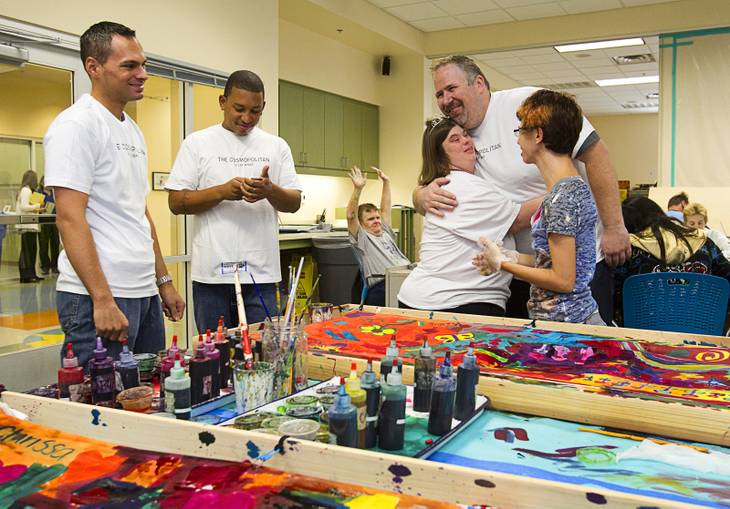On a recent Monday morning, employees from the Cosmopolitan gathered at Opportunity Village to help people with intellectual disabilities decorate scarves to be sold at a fundraiser for the Las Vegas nonprofit group, which teaches clients vocational and living skills.
The Cosmopolitan workers weren’t on the clock. Rather, they were spending their free time on the company-sponsored outing. The Cosmopolitan organizes several such events each month.
Why?
There’s the obvious good that comes from giving back to a community and helping people in need.
But volunteerism also can positively impact a business’s bottom line.
It can help attract and retain top talent. It can foster teamwork among employees. And it can raise a company’s profile among consumers.
Simply put, allowing and encouraging workers’ philanthropy makes good business sense, experts say.
For many businesses, philanthropy is an important part of company culture.
“You do it for two reasons,” said Steve McCracken, a senior vice president with Bank of America who helps organize the company’s local volunteer efforts. “The first is, it’s the right thing to do for the community. Inherently, it’s a good thing. The second thing is, from an employee satisfaction standpoint, knowing that the company they work for cares about them enough to give them the time off to volunteer makes them feel better about the company and their community.”
Bank of America gives its workers two paid hours each week to volunteer at an organization of their choice, whether it’s a school, church or nonprofit group.
Giving employees paid time off to encourage volunteerism is a fairly common approach, particularly for larger corporations. But experts say incentives don’t always need to be monetary, and less formal programs also can be effective, especially for small- and medium-sized businesses.
“Ultimately you have to create a culture where it’s easy to volunteer,” said Anne Hanson, president of CamCris Consulting, a Las Vegas-based business consulting firm. “It becomes something that you value.”
Communicating, setting goals and allowing employees to have a say in what causes they want to support all encourage a culture of volunteerism in a workplace, Hanson said.
“If employers tell employees where to volunteer, it’s really not volunteering,” McCracken said.
McCracken recommends businesses instead find broad causes that appeal to many employees, then focus on specific projects related to that cause.
At Bank of America, a council of employees from various Las Vegas branches meets regularly to plan and organize events for the company’s 2,000 local employees. The council includes all levels of employees, from tellers to executives. Last year, local Bank of America employees volunteered more than 10,000 hours to charitable causes.
“Kids are always kind of a uniting factor for us,” McCracken said. “It’s easy to take on too many projects. It’s about finding the right balance, choosing the right projects to deliver the maximum return.”
The simplest benefit of encouraging employees to volunteer is that it can improve a company’s image, both internally and externally.
Employees tend to feel more engaged and connected to a business that supports them beyond the office, Hanson said. They appreciate employers who give them an opportunity to give back.
“There’s a strong positive relationship between employee engagement and satisfaction and customer satisfaction,” she said. “It translates to the way your employees treat your customers, which ultimately has an impact on profits.”
And being recognized as a company that supports its community is good for public relations. Customers with increasing frequency are basing business decision on companies’ ethics.
It also can be an effective tool to recruit talent, said Karen Sumberg, executive vice president at the nonprofit Center for Talent Innovation in New York.
“Employees want to feel like the company is doing good, that they work for a place that is modeling the behaviors they aspire to,” Sumberg said.
Volunteer activities also can serve as great teamwork and skill-building exercises. They allow employees to take on new challenges and find different ways to solve problems, said John Harvey, CEO of Harvey Innovations, a Henderson business development and management company.
“It gets people to think outside the box. By volunteering, and especially doing it with other professionals, you see how other people think and do things,” Harvey said.
At the Cosmopolitan, many department heads arrange team-building exercises outside the office during one of several monthly volunteer activities.
“Normally, a team-building exercise would happen in a meeting room somewhere,” Cosmopolitan CEO John Unwin said.
Instead, groups such as the one that went to Opportunity Village head out into the community.
Teaming with other professionals on philanthropic projects is also a good way to build business relationships without the pressure of a workplace setting.
“We do it to help, but networking and trust comes as a part of it,” Harvey said. “People can see you in action and see that it’s not all talk.”
Often, one of the toughest parts of establishing a workplace volunteer program is getting employees to buy in and take advantage of the opportunities being offered, the experts said.
“There are going to be people who are more interested than others,” Hanson said.
Rather than focus on less-engaged employees, business owners should direct their energy and resources on supporting workers who are passionate about volunteering, Hanson said. The hope is their enthusiasm spreads.
Managers also can set a strong example for employees. The more that senior leaders participate in volunteer activities, the more likely rank-and-file workers will join in, Sumberg said.
At the Cosmopolitan, executives choose broad topics such as art, learning or food, then sponsor projects that fall into those categories to allow employees to get involved in activities they’re passionate about. Workers’ hours are tracked, and employees are rewarded with recognition and prizes based on how much time they give, Unwin said.
Allowing employees to volunteer requires an investment from a company. And like any other business investment, returns should be measured, Hanson said.
“Businesses should set goals, track those and publicize progress,” she said.
Even so, business leaders should be wary of over policing programs and requiring so much documentation that it kills the spirit of the effort.
“You want to make sure that it’s not too cumbersome,” Hanson said. “In general, most people will do the right thing. You don’t want to focus controls around the few people who aren’t.”
Unwin said it’s important for businesses to create a platform that encourages employee volunteering, then turn control over to workers. Employees at the Cosmopolitan are regularly reminded about volunteer opportunities at staff meetings and through internal communications, and workers are encouraged to share their volunteer experiences with their colleagues.
“My belief is if you give people the opportunity to participate and you let them direct it, then it’s going to be more efficient, more effective and contagious in a good way,” he said. “It becomes infectious when people come back and tell their stories, which helps it grow.
“It’s so much different than writing a check. It’s good for the soul. It’s about being a part of something. It’s more than a job; it’s about creating community.”

